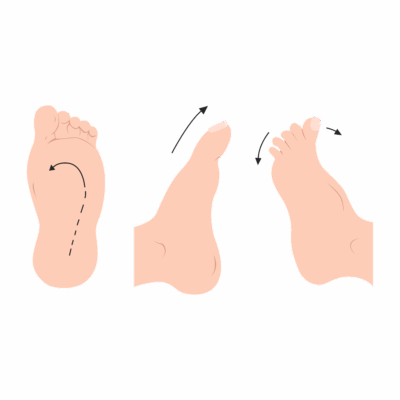Babinski’s Test
The Babinski’s Test (also known as the plantar reflex) is a neurological assessment that checks for the presence of upper motor neuron dysfunction in adults (Babinski sign). It’s part of the routine neurological exam to assess the integrity of the corticospinal tract (CST), which transmits motor signals from the brain down through the spinal cord.
How the Test is Performed
-
Client position: Supine or seated, foot bare and relaxed.
-
A dull, blunt object (e.g., the handle of a reflex hammer) is used to stroke firmly but gently along the lateral border of the sole, from heel toward toes, then across the ball of the foot toward the big toe.
-
The examiner carefully observes the response:
-
Normal response: Toes flex downward (plantarflexion), or remain still.
-
Abnormal/Positive Babinski sign: The big toe extends upward (dorsiflexes) and the other toes splay outward (fan).
-
-
The test may be performed on both feet to detect asymmetry and localize neurological dysfunction.
Clinical Significance
-
In adults and children over 2 years, a positive Babinski sign is abnormal and indicates dysfunction of the corticospinal tract (an upper motor neuron lesion).
-
Causes can include stroke, spinal cord injury, brain tumors, multiple sclerosis, or other diseases affecting the CNS.
-
-
In infants under 2 years, an upgoing big toe is normal because the corticospinal tract is not fully myelinated.
-
The test is especially useful when CNS injury is suspected—such as after trauma or with neurological symptoms.
Assessment
-
Massage therapists do not perform Babinski’s Test directly but may encounter clients who have had the test as part of medical care, or may observe related abnormal neurological symptoms.
-
If a client reports or displays upper motor neuron signs (spasticity, uncontrolled movements, abnormal reflexes, impaired coordination), document observations and refer appropriately.
-
Always defer to a physician or neurologist for neurological assessment and diagnosis.
Treatment
-
If abnormal upper motor neuron signs (like a positive Babinski) are known or suspected:
-
Do not perform deep tissue or vigorous techniques over the spine or CNS-affected limb.
-
Be cautious with positioning, range of motion, and manual therapy to avoid exacerbating neurological symptoms.
-
Prioritize comfort, relaxation, gentle soft tissue work, and monitor for unusual responses.
-
Encourage communication with the client’s medical team for coordinated care and safe modifications.
-
Safety and Referral
-
Immediate referral is warranted for:
-
New, unexplained neurological symptoms (especially weakness, numbness, loss of balance, or abnormal reflexes).
-
Signs suggesting a possible stroke, spinal cord injury, or CNS disease.
-
-
Continued therapy should only be done with clearance from the client’s medical provider if upper motor neuron dysfunction is present.

